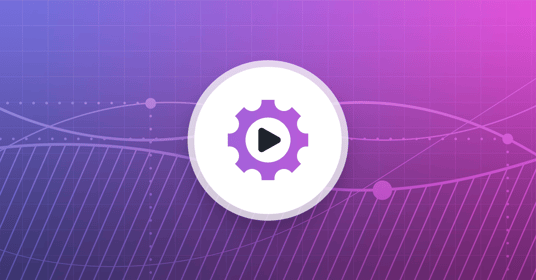Get a Free Trial
Creating, executing, and maintaining reliable tests has never been easier.
Software testing and quality assurance are the cornerstone of software development, connecting early-stage code to the customer to ensure that the application or website not only works as expected, but provides a delightful experience. Now that every industry, including healthcare, banking, and hospitality, is competing on the quality of their digital customer experience, the role of quality assurance is even more essential to overall company success.
Yet software testing and quality assurance have sometimes been a neglected component of transformations like cloud adoption, DevOps, and CI/CD. Despite their crucial role in accelerating development cycles and delivering a satisfying user experience, many software development organizations have overlooked the potential of software testing as an enabler of faster, better development. That’s why more organizations are embracing quality engineering, a holistic approach to software quality that helps companies unlock the full potential of the new world of software development.
Quality Engineering is Transforming Software Development
The software development life cycle is being transformed by cloud computing, AI and machine learning, the adoption of microservices, as well as consumer expectations for delightful experiences across B2B and B2C applications. In response, the software industry is embracing methodologies like DevOps and Agile, CI/CD, and shift-left testing to help their teams innovate faster without breaking their application. But, as the saying goes, this is easier said than done. Cultural and procedural obstacles continue to slow down DevOps and agile adoption.
Quality engineering, where continuous testing is practiced in a culture of quality, embraces a high-impact combination of manual and automated testing that allows everyone to participate in an organization’s quality strategy. When testing is done early and often, quality engineers, developers, and product owners can ask bigger questions about product quality while also deploying new code with confidence.
Adoption of DevOps is Still in Transition
Mabl’s Testing in DevOps Report found that just 11% of software professionals consider their teams fully DevOps, indicating that most teams are still navigating their transformation. This gives software testers the opportunity to experiment with strategies for integrating testing into their organization’s DevOps processes from the start.
Like DevOps, quality engineering isn’t a final destination. Instead, both strategies capture a state where software development organizations can continuously innovate and improve with fast, iterative deployments. DevOps ensures that teams can deliver new features or products faster and quality engineering ensures they can do so without risking defects or product performance. Since most teams are still building their DevOps practice, quality assurance is well-positioned to build a complementary quality engineering practice that enforces best practices throughout the software development lifecycle.
Silos Between Teams are Coming Down
A key ingredient for the successful adoption of both DevOps and quality engineering: collaboration. The few teams that consider themselves full DevOps were most likely to have a strong culture of quality across their entire organization, making it easier to test, fix, and ship new products.
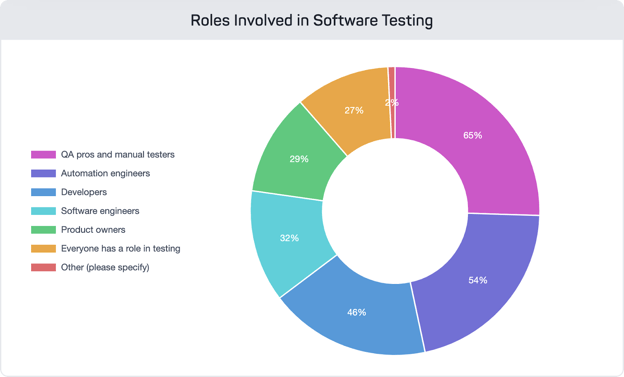
Software testing is increasingly collaborative
As more teams adopt DevOps and quality engineering, they’ll see more team members contributing to software testing. Developers will focus on testing that provides fast feedback on code regressions, while QA and business stakeholders will focus on end-to-end testing that ensures critical user journeys meet the customer expectations. Quality engineers move into a leadership role that coordinates testing throughout all phases of development, high-impact manual testing, managing overall testing strategy, and overseeing testing done by other team members. When entire teams collaborate on product quality, software testing is no longer a bottleneck in the development process and teams can ask bigger questions about quality, including non-functional requirements.
Teams are Moving to Continuous Testing
The term shift-left testing has grown in popularity over the past few years as software development leaders looked for ways to accelerate delivery schedules. But with consumer demands for seamless digital experiences reaching new highs post-2020, leading quality engineering teams are turning to a new model: continuous testing.
Shift-left testing activities meant that more tests were moving earlier in development. Though software testing would still happen in staging and production environments, developers would start the testing process at the coding or pull request stages. Continuous testing takes this concept a step further by automating some of these activities - and actually requires passing tests to merge a branch or approve a pull request.
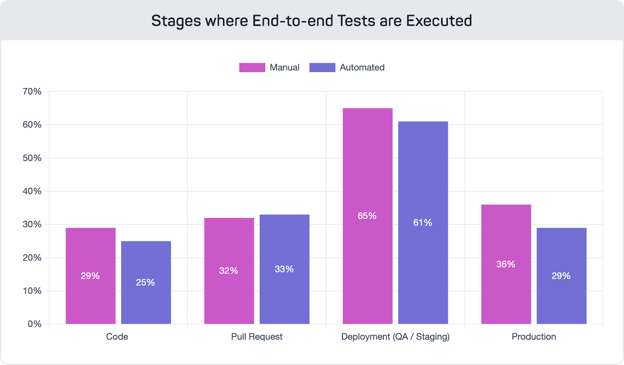
The shift to continuous testing
The 2022 Testing in DevOps Report found that a growing share of software development teams are running end-to-end tests in the earlier stages of the SDLC. Though testing is most commonly taking place in the deployment stage of development, a quarter of teams have shifted end-to-end testing all the way to the left.
The shift towards continuous testing is a likely factor in the number of software organizations discovering bugs earlier in development.
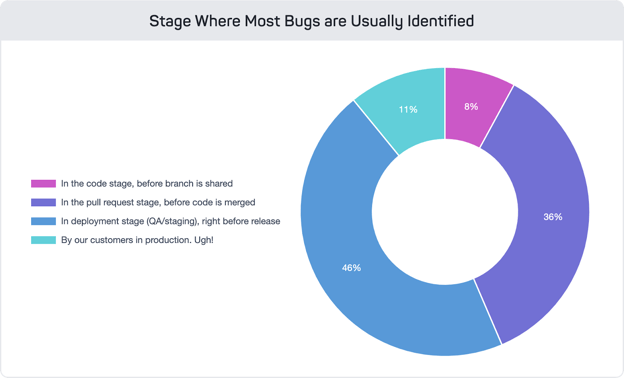
Bugs are being caught earlier
Despite the fact that the bulk of end-to-end tests are being run in the deployment phase of the software development life cycle, a growing number of defects are being caught in the pull request stage. Even more impressively, 8% of bugs are being identified in the code stage, when they’re easiest to fix. Unfortunately, however, those defects are still outnumbered by the bugs being caught in production, when they have a real impact on revenue and customer retention.
Quality Strategies Are Going Beyond Functional Requirements
Finally, quality engineering is empowering development teams to ask bigger questions about product quality.
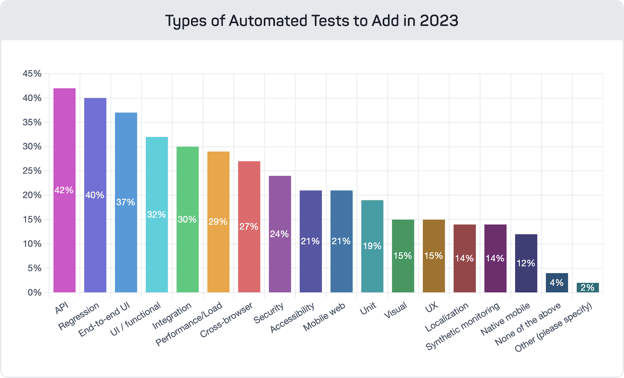
QA teams are looking to add functional and non-functional testing in 2023
Most test automation efforts are focused on UI/functional testing, unit testing, regression testing, and integration testing. Though these are important in developing a thorough automated testing strategy, they only capture part of the full customer experience. As more teams adopt quality engineering, that focus is broadening to include automated non-functional tests such as performance and accessibility. When asked about their software testing goals for 2023, quality practitioners identified a diverse range of priorities that included automated API testing, end-to-end UI testing, and performance testing.
“Quality” is increasingly being defined by the user experience. This means shifting away from the binary pass/fail mindset to considering more qualitative aspects such as accessibility and performance. 53% of consumers expect web pages to load in 3 seconds or less, with many leaving a website altogether if their experience is too slow. Integrating performance testing into an organization’s unified test automation strategy is critical for succeeding in a digital-first world.
Build Better Apps and Better Software Teams with Quality Engineering
QA is in a unique position to help their organizations succeed in the new world of agile development that’s hyper-attuned to the full customer experience. As more software development teams embrace quality engineering, they’ll be prepared to support DevOps adoption, catch bugs earlier in development, ensure quality more quickly, and broaden their vision of product quality for a more holistic user experience that stands out among the competition.
Start your quality engineering journey today with a free 14 day trial from mabl.


